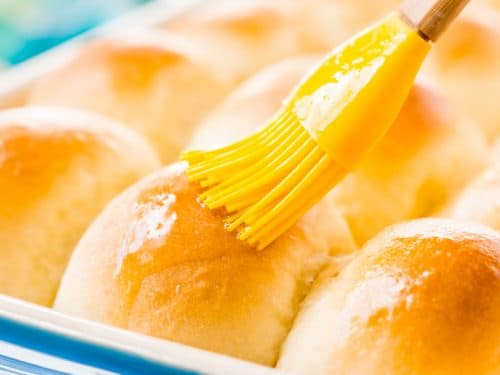Homemade Yeast Rolls for Your Thanksgiving Meal
TEXARKANA, Ark. –
If a package of brown and serve rolls are always on your Thanksgiving dinner table, surprise your family and friends with homemade yeast rolls. Scratch those brown and serve rolls from your shopping list and add the ingredients needed to make your own yeast rolls.
Yeast rolls can seem intimidating, but you can create homemade yeast rolls this holiday, whether you are a beginner a or novice cook.
The right ingredients make the best rolls
The baking ingredients are crucial for successful bread baking. Most of the ingredients are staples you probably already have in the kitchen
Yeast is the heart of the bread making process.
It makes the dough rise and gives home-baked bread its wonderful taste and aroma.
In each yeast envelope, there are thousands of living plant-like microorganisms. When activated by warm liquid, and fed by starch or sugar, the yeast releases tiny bubbles of carbon dioxide gas. This gas is what makes the dough rise and achieve its light texture after baking.
There are several types of yeast; active dry yeast, rapid rise yeast, compressed or cake yeast or bread machine yeast. Choose the type which works best for your situation.
Flour is an essential
Wheat is the most common type of flour used in bread baking. It includes all-purpose flour, bread flour, and whole wheat flour.
Wheat is rich in gluten, a protein that gives dough its elasticity and strength. When yeast and flour are mixed with liquid, then kneaded or beaten, the gluten forms and stretches to create a network that traps the carbon dioxide bubbles produced by the yeast.
Water is the most important liquid, because it does two critical things: it dissolves and activates the yeast, and blends with the flour to create a sticky and elastic dough..
Milk, buttermilk, cream or juice may be added to enhance the flavor or texture. Only warm liquids should be added to dry ingredients in a recipe, because liquid that is too cool will slow or stop yeast action, and too hot will kill the yeast and prevent it from rising.
Temperature is key
The ideal temperature ranges are 100 to 110 degree F., when yeast is dissolved in liquid; or 120 to 130 degree F when dissolved yeast is added to dry ingredients.
Sweetener is essential in adding the brown color to the bread’s crust, as well as flavor. Brown sugar, honey, molasses, jams and dried fruit may also be used.
Yeast bread will not work without salt. It is important in bread-baking because it slows rising time, allowing the flavor of the dough to develop. It also adds structure to the dough by strengthening the gluten, which keeps the carbon dioxide bubbles from expanding too rapidly.
Eggs add color and flavor to breads.
They also help make the crust tender. Eggs add richness and protein. Some recipes call for eggs to be used as a wash to add color.
It’s also important to note that yeast breads must have fat to make the bread moist and tender. Butter, margarine, shortening or oil slows moisture loss, helping bread stay fresh longer.
Do not substitute oil for margarine or shortening unless the recipe calls for it.
If you would like Rising to the Occasion: Home Baked Breads, contact the Miller County Extension Office, 870-779-3609 or visit us in room 215 at the Miller County Courthouse.
Here is my sister’s recipe for yeast rolls. They are light, fluffy and easy to make. If you make too much dough, it can be used to make homemade cinnamon rolls.
Homemade Yeast Roll Recipe
- 1 package rapid rise yeast
- 1/2 cup warm water
- 1/2 cup shortening
- 1/2 cup sugar
- 1 egg, beaten
- 2 cups warm water
- 1 1/2 teaspoons salt
- 8 cups flour
- Dissolve yeast in one half cup warm water.
- Cream the shortening and sugar in mixing bowl;
- add the beaten egg, 2 cups warm water, salt, and yeast mixture; mix slightly.
- Gradually add flour and mix well.
- Remove from mixing bowl and knead dough on floured surface.
- Place in a large bowl coated with cooking spray and grease top of dough.
- Cover with cling wrap or wax paper and put in the refrigerator until ready to use.
- When ready to use, take as much dough as needed from bowl.
- Shape rolls and place in greased pan (pan size will be determined by number of rolls needed-a small crowd an 8x8 should work, if cooking for a group you may need a 9x13.)
- Let rise 3 hours and bake in 400 degree oven for 12 to 15 minutes.
- Brush lightly with butter or margarine upon removing from oven.
- Once cool, remove from the pan and serve.
Media Contact: Carla Due
County Extension Agent - FCS
U of A Division of Agriculture
Cooperative Extension Service
400 Laurel Street, Suite 215 Texarkana AR 71854
(870) 779-3609
cdue@uada.edu
Related Links
The Arkansas Cooperative Extension Service is an equal opportunity institution. If
you require a reasonable accommodation to participate or need materials in another
format, please contact your County Extension office (or other appropriate office)
as soon as possible. Dial 711 for Arkansas Relay.
Pursuant to 7 CFR § 15.3, the University of Arkansas System Division of Agriculture
offers all its Extension and Research programs and services (including employment)
without regard to race, color, sex, national origin, religion, age, disability, marital
or veteran status, genetic information, sexual preference, pregnancy or any other
legally protected status, and is an equal opportunity institution.
